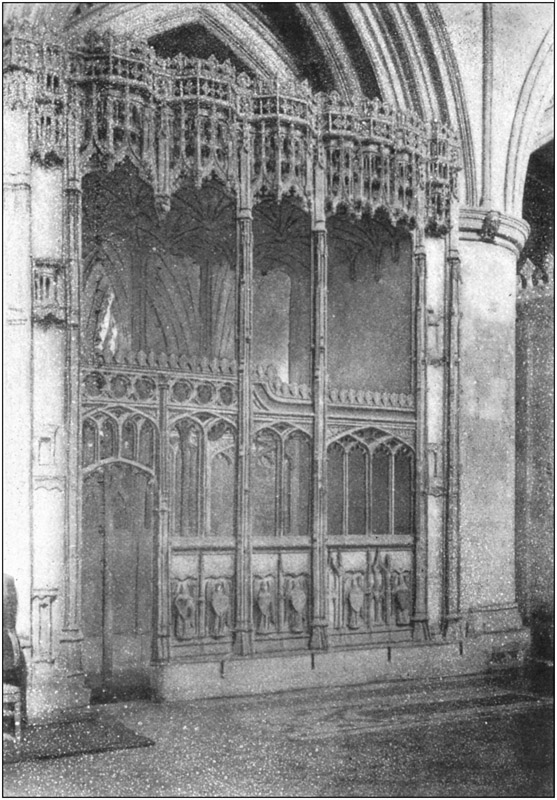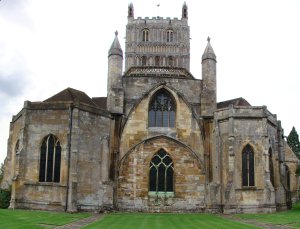One of the Marian shrines omitted by Canon Stevenson is that of Our Lady of Tewkesbury. The origin of the monastic foundation was in the early eighth century but it was refounded as a Benedictine house by Robert FitzHamon in 1102, and the church was consecrated in 1121.
The Victoria County History of Gloucestershire account of the abbey can be read at Houses of Benedictine monks: The abbey of Tewkesbury
The abbey was under the patronage of the Virgin and in the later middle ages the eastern Lady Chapel housed the devotional image of Our Lady. This is recorded in the will of Isabella Despenser, heiress of the lordship of Tewkesbury who was married twice to peers called Richard Beauchamp - the first was Earl of Worcester and the second his cousin the more famous Earl of Warwick. In her will of 1439 the Countess made various bequests, including these to Marian shrines, cited by Fr Bridgett in his book:
I desire that a chalice be made of my great sharpe and offered to our Lady in the Lady Chapel at Tewkesbury ; and to our Lady of Caversham I bequeath a crown of gold, made of my chain, weighing twenty-five pounds, and other broken gold in my cabinet. ... I will that my tablet, with the image of our Lady, having a glass for it, be offered unto our Lady of Walsingham ; as also my gown of green alyz cloth of gold with wide sleeves ; and a tabernacle of silver, like in the timber to that over our Lady of Caversham. To our Lady of Worcester my great image of wax, now in London.'
Of these shrines she was patron both at Tewkesbury and Caversham - which we shall visit in a few days - and Worcester was the diocesan centre.
Countess Isabella’s Chantry for herself and her two husbands in Tewkesbury Abbey
Image: Projrct Gutenberg/ Bell’s Guides 1906
There is something about the life of Countess Isabella and her successors at The Lords of Tewkesbury, part 3
The Lady Chapel the Countess knew, and where her only son Henry Duke of Warwick was to be buried in 1446, was part of the fourteenth century rebuilding of the chevet of the abbey church in association with her Clare and Despenser ancestors. Unfortunately following the dissolution when the good people of Tewkesbury raised the £453 scrap value of the church and saved it as their parish church the Lady Chapel, together with another dedicated to St Nicholas attached to the north transept were demolished at some point as extraneous and presumably their materials sold off. Sufficient remains of the Lady Chapel to work out what it would have looked like and its foundations are now marked out in the turf at the east end.

Tewkesbury Abbey from the south east.
The Lady Chapel projected eastwards on the right
Image: Tewkesbury Abbey
The east end of Tewkesbury Abbey
The western wall of the destroyed Lady Chapel with its west window and the blocked entrance arch can be seen.
Image: Wikivoyage
The fate of the statue itself is a cautionary one. Apparently it survived in the abbey until the time of King James I - the Churchwarden’s records suggest a conservative mood prevailed in church life and at the end of the reign of Queen Mary I the townspeople had been petitioning for a restoration of the abbey as a monastery. However late in the time of King James one local Puritan got exercised by the statue, brought and won a legal case for its removal, and obtained the statue. He then proceeded to hollow it out and turned it into an animal trough. All the animals who drank from it died, his children became lame , blind or suffered from horrible diseases, and eventually he himself tripped over it and fell into his own well where he drowned....
In recent years a modern metal sculpture of Our Lady Queen of Peace was installed in the retro choir. This can be seen at Tewkesbury Abbey "Our Lady Queen of Peace”
To mark the 900th anniversary this year of the consecration of the abbey the PCC has commissioned a new statue of Our Lady based on the medieval abbey seal.

Image: Tewkesbury Abbey
Our Lady of Tewkesbury Pray for us






No comments:
Post a Comment